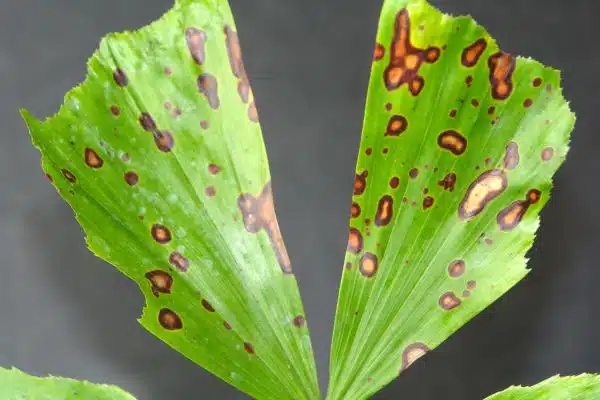Fishtail palm, scientifically known as Caryota mitis, is a tropical plant that belongs to the Arecaceae family. This plant has become increasingly popular among indoor and outdoor gardeners due to its unique foliage and easy maintenance. Fishtail palm is native to Southeast Asia and can grow up to 30 feet tall, making it an excellent choice for those who want to add a touch of the tropics to their home or garden.
Growing and caring for fishtail palm requires specific knowledge and techniques to ensure the plant thrives in its environment. In this article, we’ll explore the essentials of growing and caring for fishtail palm, including planting techniques, watering schedules, soil requirements, pest control methods, and more. Whether you’re an experienced gardener or just starting out, our guide will equip you with everything you need to know about one of the most iconic tropical plants around.
Understanding The Fishtail Palm Plant
The Fishtail Palm Plant is a fascinating specimen that belongs to the genus Caryota. Its unique leaf shape resembles that of a fish’s tail, hence its name. This tropical plant species is native to Southeast Asia and Australia, and it can grow up to 25 feet tall in the wild. The Fishtail Palm is commonly used for ornamental purposes due to its attractive appearance.
The plant characteristics of the Fishtail Palm make it an excellent choice for indoor decoration as well as outdoor landscaping. The leaves of this palm are bipinnate, meaning they have multiple pairs of leaflets on each stem. These leaves can grow up to 10 feet long and 5 feet wide, making them an impressive sight when fully grown. Additionally, the Fishtail Palm produces small yellow or white flowers that bloom in clusters.
One of the many uses of the Fishtail Palm is for medicinal purposes. In traditional medicine, different parts of the plant are used to treat various ailments such as fever, coughs, and inflammation. The palm also plays a significant role in local cultures where it is used as a source of food and building material for homes and other structures. Overall, the Fishtail Palm Plant is a versatile and useful species with numerous benefits beyond its aesthetic appeal.
As we move further into understanding how to care for this unique plant species, choosing the right pot and soil will be crucial in ensuring optimal growth conditions.
Choosing The Right Pot And Soil
Selecting the right pot size and soil type is critical to providing a healthy environment for your fishtail palm. Choosing a pot that is too small can stunt the growth of your plant, while selecting one that is too large can lead to overwatering and root rot. The appropriate pot size for your palm will depend on its current size and the amount of space it needs to grow.
When selecting soil for your fishtail palm, it is important to choose a well-draining mix that retains moisture without becoming waterlogged. A mixture of peat moss, perlite, and sand is recommended as it provides both drainage and moisture retention. Avoid using heavy soils such as clay or garden soil which do not allow adequate drainage.
In addition to choosing the right pot size and soil type, make sure to add a layer of rocks or gravel at the bottom of your pot before adding the soil. This will help ensure proper drainage and prevent water from accumulating in the bottom of the pot. By taking these steps, you can provide your fishtail palm with an optimal growing environment that will promote healthy growth.
As you have learned about selecting the right pot size and soil type for your fishtail palm, it’s time to move on to understanding how much water this plant needs. Proper watering technique ensures that your plant stays hydrated without becoming oversaturated with water.
Watering Your Fishtail Palm
As you probably know, the Fishtail Palm is native to tropical regions and thrives in humid environments. Considering this, it’s important to water your palm tree accordingly. The frequency of watering will depend on several factors such as the size of the pot or container, temperature, and humidity levels.
To determine whether your Fishtail Palm needs watering, check the top inch of soil. If it feels dry to the touch, it’s time to water your plant. However, be careful not to overwater your palm tree as this can lead to root rot and other issues. Signs of overwatering include yellowing leaves or a mushy stem.
Watering frequency may vary depending on different circumstances. For instance, during hot summer months when there is high humidity and temperatures are consistently above 90°F (32°C), you may need to water it more frequently than usual. On the other hand, during winter months when temperatures are cooler and humidity levels are lower, you might need to reduce watering frequency. Remember that proper watering is crucial for healthy growth of your Fishtail Palm!
To ensure proper drainage for your Fishtail Palm, make sure that the pot or container has drainage holes at the bottom. This allows excess water to drain out and prevents standing water from saturating the soil in which roots grow. In addition, use a well-draining soil mix that is suitable for palms since they require good air circulation around their roots. With these precautions in mind, providing adequate drainage for your Fishtail Palm will help prevent problems related to overwatering and promote healthy growth!
Providing Proper Drainage
Proper drainage is essential for the healthy growth and development of fishtail palm. Without it, the roots can become waterlogged, leading to root rot and other fungal diseases. Therefore, ensuring that your plant has sufficient drainage is crucial in maintaining its overall health.
The importance of drainage cannot be overstated. Fishtail palms thrive in well-draining soil that allows excess water to drain away quickly. When planting your palm, make sure to choose a pot or container with adequate drainage holes at the bottom. This will allow any excess water to escape, preventing it from accumulating and stagnating around the roots.
Common drainage problems include containers without drainage holes, pots that are too small for the plant’s size, and using heavy soils that do not allow for proper water movement. If you notice any signs of poor drainage such as yellowing leaves or a mushy stem, take immediate action to remedy the situation. Repotting your plant into a larger container with better drainage or adjusting watering habits may be necessary to avoid further damage.
Ensuring proper drainage is one of the most important aspects of caring for your fishtail palm. By providing an ideal growing environment for your plant, you can help ensure its long-term health and beauty. In the next section, we will discuss another key aspect of taking care of your fishtail palm: fertilizing it regularly.
Fertilizing Your Fishtail Palm
Fertilizing is a crucial aspect of maintaining the health and growth of your fishtail palm. When it comes to fertilizers, you have two options: synthetic or organic. While synthetic fertilizers are commonly used and easily available, they contain chemical substances that may cause harm to your plant’s health in the long run. Organic fertilizers, on the other hand, are made from natural substances like animal wastes, composted manure, and fish emulsion that promote healthy growth without causing any damage.
Using organic fertilizers is highly recommended for your fishtail palm because they provide essential nutrients such as nitrogen, phosphorus, and potassium that improve soil fertility and plant growth. They also help in retaining moisture in the soil which is important for the optimal growth of your plant. Synthetic fertilizers can be harsh on your plants if not used in moderation; they can lead to root burn or toxic buildup of chemicals in the soil.
When it comes to using organic fertilizers, timing is key. It’s best to apply them during active growing periods like spring or summer when your plant needs more nutrients to grow healthy leaves and stems. You can use a balanced fertilizer with an N-P-K ratio of 10-10-10 every three months during these periods. Remember not to over-fertilize as this can lead to nutrient toxicity or salt buildup in the soil. A well-fertilized fishtail palm will thrive under optimal conditions.
Transition into Pruning and Trimming Techniques:
Now that we’ve talked about how to keep your fishtail palm healthy through proper fertilization techniques let’s explore some tips on how to prune and trim it for optimal growth and aesthetics without causing damage or stress to the plant.
Pruning And Trimming Techniques
After fertilizing your fishtail palm, it’s important to consider pruning techniques and trimming tips to keep your plant healthy and looking its best. Pruning is the process of removing dead or damaged fronds from the plant. This helps improve air circulation around the plant, which can prevent fungal diseases from taking hold.
When pruning, it’s important to use a clean pair of pruning shears to prevent the spread of disease. Cut off any fronds that are yellow or brown, as these are likely dead or dying. Be sure not to over-prune, as this can weaken the plant and make it more susceptible to pests and diseases.
Trimming is similar to pruning but involves removing small sections of living fronds. This can be done for aesthetic purposes, such as shaping the palm into a specific form. When trimming, be sure not to cut too close to the trunk or leave stubs on the frond, as both of these can lead to pest infestations and disease. By following these pruning techniques and trimming tips, you can help ensure that your fishtail palm remains healthy and beautiful for years to come.
As with any plant, managing pests and diseases is an important part of caring for your fishtail palm. In the next section, we’ll discuss some common pests and diseases that affect this type of palm tree and how you can identify them. By being proactive about pest management, you can help prevent damage to your plant and keep it looking its best.
Managing Pests And Diseases
Preventive measures are essential in the management of pests and diseases in fishtail palm. Regular inspection of the plant is necessary to detect any signs of infestation early enough before they cause any significant damage. Moreover, maintaining a clean and weed-free environment around the plant will help prevent the harboring of pests and diseases. Additionally, avoiding overcrowding the plants will reduce the chances of spreading diseases.
When it comes to natural remedies for controlling pests and diseases, there are several options that you can explore. Some common natural remedies include spraying the leaves with neem oil or insecticidal soap to control insects such as spider mites and mealybugs. Also, a mixture of baking soda, water, and vegetable oil can be used to treat fungal infections such as powdery mildew. However, it’s important to note that prevention is always better than cure when it comes to managing pests and diseases.
Overall, maintaining a healthy fishtail palm plant requires adequate preventive measures against pests and diseases. Natural remedies can also be used as an effective control measure if detected early enough. In the subsequent section, we will discuss how controlling temperature and humidity contributes significantly to the growth and care of your fishtail palm plant.
Controlling Temperature And Humidity
The Fishtail Palm is a symbol of elegance and beauty. It requires proper temperature control to thrive and grow, which makes it an ideal indoor plant. This tropical plant thrives in temperatures between 60-75°F (15-24°C). Any sudden fluctuations or extreme temperatures can cause damage to the plant.
To ensure that your Fishtail Palm stays healthy, you need to manage the humidity levels in its environment. This plant requires a high level of humidity, similar to its natural habitat in tropical rainforests. A humidity level of around 50% is optimal for this species. You can achieve this by placing a tray with water near the plant or using a humidifier.
Maintaining proper temperature control and managing humidity levels are crucial steps in caring for your Fishtail Palm. These factors play an essential role in the growth and development of this beautiful tropical plant. By following these simple guidelines, you can keep your Fishtail Palm healthy and thriving for years to come.
Transitioning into the subsequent section about lighting requirements for fishtail palm, it’s important to note that light also plays a significant role in this plant’s overall health and well-being. With proper temperature control, humidity management, and lighting requirements met, you’ll have a flourishing Fishtail Palm in no time!
Lighting Requirements For Fishtail Palm
Maintaining an adequate light source is crucial for the growth and health of fishtail palms. Indoor plants require bright, indirect light to thrive, while outdoor specimens can tolerate more direct sunlight. However, it’s essential to avoid prolonged exposure to full sun as this can cause leaf scorching and damage.
If you’re growing your fishtail palm indoors, consider placing it near a south-facing window that receives plenty of natural light throughout the day. You may also need to supplement with artificial lighting if natural light is scarce or insufficient. LED grow lights are an excellent option for indoor planting as they emit a spectrum of wavelengths that mimic natural sunlight.
When growing outdoors, monitor the intensity of the light your fishtail palm receives. It’s best to avoid exposing them to midday sun during summer months when temperatures are highest. Instead, position them in areas where they receive morning or afternoon sun with partial shade at other times of the day. Supplemental lighting options are also available for outdoor planting if you live in regions with shorter daylight hours or experience extended periods of cloud cover.
In conclusion, providing appropriate lighting conditions is crucial for the health and vitality of your fishtail palm plant. Whether you’re growing indoors or outdoors, it’s essential to monitor the amount and intensity of light exposure your plant receives. By following these guidelines, you can ensure optimal growth and development for your fishtail palm plant. In the next section, we will explore how to propagate fishtail palm plant successfully.
Propagating Fishtail Palm
Fishtail palm is a popular and attractive species of aquatic palm, and it can be propagated and grown from seed. Seed collection should be done when the fruit is ripe and the seeds are mature. Propagation techniques for fishtail palm include direct sowing, stratification, and pre-germination. It is important to note that the seeds are sensitive to water and high temperatures, so care must be taken when propagating.
Seed Collection
Fishtail palm is an aquatic plant that can be propagated through seed collection. In order to collect seeds, one must wait until the fruit has ripened and turned brown or black in color. The fruit should then be harvested carefully and allowed to dry for a few days before removing the seeds.
Once the seeds have been collected, they should be stored in a cool, dry place to prevent moisture from causing them to mold. Seed storage can be extended by storing them in an airtight container or plastic bag. Germination techniques require planting the seeds in well-draining soil and keeping them moist until they sprout.
To ensure successful germination, it is recommended that gardeners soak the seeds in water overnight before planting them. This helps to soften the outer layer of the seed, allowing for easier germination. Additionally, frequent watering of the soil will help promote growth and development of the fishtail palm seedlings. With proper care and attention, these seedlings will grow into beautiful palms that add beauty and character to any aquatic environment.
Propagation Techniques
Propagation techniques are essential in ensuring the successful growth and development of fishtail palm. Aside from seed collection, other propagation methods such as leaf cutting and air layering can also be used to propagate this plant. Leaf cutting involves taking a healthy leaf from the mother plant and planting it in well-draining soil. It is important to ensure that the leaf is planted at the correct depth and kept moist until new growth appears.
Air layering, on the other hand, involves creating a small cut on the stem of the mother plant and wrapping it with moist sphagnum moss or soil. After a few weeks, roots will start to grow through the moss or soil, and once they have developed enough, the new plant can be separated from its mother plant and transplanted into its own container.
Regardless of which propagation method is chosen, it is important to provide proper care and attention to ensure successful growth. Adequate light exposure, well-draining soil, regular watering, and occasional fertilization are all factors that contribute to healthy fishtail palm growth. With these techniques in mind, gardeners can easily propagate fishtail palm for their own personal enjoyment or for serving others who appreciate aquatic plants.
Transplanting Your Fishtail Palm
Just like how fish swim from one environment to another, your fishtail palm may also need a change of scenery. Transplanting your plant into a larger container will give it ample space for growth and provide it with fresh soil that is rich in nutrients. The optimal time to repot your fishtail palm is during the spring or summer months when the plant’s growth is at its peak.
Before repotting, ensure that you have all the necessary tools such as a larger-sized container, well-draining soil mix, and gloves to protect your hands. Remove the plant gently from its existing container by loosening the soil around it and pulling it out carefully. Once removed, inspect the roots for any signs of damage or disease. Prune any dead or diseased roots before placing the plant into its new container.
Repotting tips aside, maintaining your fishtail palm’s appearance is equally important. As an aquatic plant expert, I highly recommend keeping this tropical beauty away from direct sunlight as it can scorch its leaves. Instead, place the plant in an area where it can receive bright but indirect light. Additionally, mist the leaves regularly to increase humidity levels around the plant and prevent leaf browning. With proper care and attention to detail, your fishtail palm will thrive for years to come!
Maintaining Your Fishtail Palm’S Appearance
After successfully transplanting your fishtail palm, it is essential to maintain its appearance. Trimming frequency will depend on the growth rate of your plant, so it’s important to keep an eye on this. Cutting off dead or damaged fronds can help stimulate new growth and enhance the overall appearance of the palm. However, be careful not to over-trim as this can cause stress to the plant.
Leaf cleaning techniques are also crucial in maintaining a healthy fishtail palm. Dust and debris can accumulate on the leaves, limiting their ability to absorb sunlight and perform photosynthesis. A simple wipe with a damp cloth or spraying with water can help remove any unwanted buildup. It is essential not to use any harsh chemicals as this can damage the leaves and harm the overall health of your plant.
By regularly trimming and cleaning its leaves, you will ensure that your fishtail palm remains healthy and beautiful for years to come. In addition, these maintenance practices can help prevent common problems such as pests and diseases from affecting your plant. In the next section, we will discuss some common issues that may arise when caring for your fishtail palm and provide solutions for each one.
Common Problems And Solutions
As with any plant, the fishtail palm is not immune to problems that can arise during its growth and development. One common issue that many growers may face is yellowing leaves. This can be caused by a variety of factors, including overwatering, improper fertilization, or lack of sunlight. To prevent yellowing leaves, it is important to ensure that the plant receives adequate water and nutrients while also being placed in a location with sufficient sunlight.
Another problem that can occur with fishtail palms is fungal infections. These infections can manifest in various ways, from discolored spots on the leaves to wilting and dying fronds. To treat fungal infections, it is important to first identify the type of fungus present and then choose an appropriate fungicide for treatment. It may also be necessary to prune affected fronds or adjust watering and humidity levels to prevent further spread of the infection.
Overall, caring for a fishtail palm requires attention and diligence. By taking proactive measures to prevent problems such as yellowing leaves or fungal infections, growers can ensure the long-term health and vitality of their plants.
Moving forward into frequently asked questions about fishtail palm care, growers may have questions regarding specific aspects of care or how different factors impact their plants’ growth. Let’s explore some common questions and answers in order to better understand how to care for these beautiful trees.
Frequently Asked Questions About Fishtail Palm
One common problem faced by those who grow fishtail palm is overwatering. Overwatering can lead to root rot, which can eventually kill the plant. To avoid this, it is recommended that you only water the plant when the soil is dry to the touch. Additionally, make sure that the pot has proper drainage so that excess water can easily escape.
Another issue that may arise when caring for fishtail palm is pests. Common pests for this plant include spider mites and mealybugs. You can prevent these pests by regularly checking your plant and keeping it clean. If you notice any signs of an infestation, use a gentle insecticide or natural remedy to get rid of them.
Overall, fishtail palm is a great addition to any indoor garden or tropical landscape. Not only does it add a unique and exotic touch to your space, but it also has numerous benefits as an indoor plant. Fishtail palm helps purify the air by removing toxins such as formaldehyde and benzene, making it a healthy choice for your home or office. Additionally, its low maintenance requirements make it an easy-to-care-for option for those who are new to gardening.
For those interested in creating a tropical garden, there are a few tips to keep in mind when growing fishtail palm. Firstly, make sure that you choose a location with plenty of sunlight and humidity, as this will help your plant thrive. Secondly, consider planting other tropical plants alongside your fishtail palm to create a cohesive look and feel. Finally, don’t be afraid to experiment with different colors and textures in order to create a truly unique space.
In conclusion, growing and caring for fishtail palm requires attention to detail and regular maintenance in order to avoid common problems such as overwatering and pests. However, if done correctly, this unique plant can provide numerous benefits both aesthetically and functionally in both indoor and outdoor settings.
Final Thoughts On Growing And Caring For Fishtail Palm
As an aquatic plant expert, it may seem ironic that I am writing about the Fishtail Palm. However, this palm tree is not your typical plant. It has unique features that make it stand out from other plants. For one, it can grow up to 20 feet high and has a distinctive fishtail-like leaf shape. This plant can also purify indoor air quality by removing pollutants, making it a perfect addition to any home or office space.
The Fishtail Palm is an excellent choice for those who want to decorate their homes with indoor plants. Its unique appearance adds a touch of elegance and sophistication to any room. You can place it in a large pot or planter and use it as a centerpiece in your living room or dining area. Alternatively, you can group several Fishtail Palms together for a more dramatic effect.
In summary, growing and caring for the Fishtail Palm is not as challenging as some people might think. With proper care and maintenance, this plant can thrive indoors and add beauty to any space. Whether you are looking to improve indoor air quality or just add some greenery to your home decor, the Fishtail Palm is an excellent choice that offers numerous benefits of indoor plants while being aesthetically pleasing at the same time.
Frequently Asked Questions
How Long Does It Take For A Fishtail Palm To Grow To Its Full Height?
The growth speed of a fishtail palm can vary depending on various factors such as environmental conditions and maintenance practices. On average, the plant can grow up to 6-10 feet in height within a couple of years. However, it may take several years for the palm to reach its full height potential which can be up to 30 feet tall. The optimal conditions for growing fishtail palms include providing them with well-draining soil, regular watering, and exposure to bright but indirect sunlight. Additionally, fertilization with a balanced fertilizer once every four months can help enhance growth. Proper care and maintenance are essential for ensuring that the palm grows at a healthy rate and reaches its full height potential in due time.
Can Fishtail Palms Be Grown Indoors?
Ahoy there! As an expert in aquatic plants, I have been asked if the fascinating fishtail palm can be grown indoors. The answer is yes, but it requires proper indoor care and lighting requirements. Fishtail palms thrive in bright indirect light, so placing them near a north or east-facing window is ideal. However, direct sunlight should be avoided as it may scorch their leaves. These palms also require high humidity levels and moist soil, so misting the leaves and watering frequently is necessary. With the right care, you can enjoy the beauty of these tropical palms inside your home. Happy planting!
Is It Okay To Prune A Fishtail Palm If It Has Yellow Or Brown Leaves?
Pruning a fishtail palm is generally safe if done with proper techniques. When yellow or brown leaves are observed, it is best to remove them as they could be a sign of disease or pest infestation. It is recommended to use clean pruning tools and make cuts just above the base of the leaf stem, being careful not to damage the trunk. Leaf discoloration may have various causes such as overwatering or nutrient deficiency, which should be addressed accordingly. Proper care and maintenance practices such as providing adequate sunlight, watering appropriately, and fertilizing regularly can prevent leaf discoloration and promote healthy growth of fishtail palms. As an aquatic plant expert, it is essential to prioritize the well-being of plants and offer guidance on how to properly care for them.
How Often Should I Fertilize My Fishtail Palm?
Like a fish swimming in a nutrient-rich pond, the fishtail palm requires regular fertilization to thrive. To maintain its lush green foliage and vibrant growth, it’s important to establish a fertilizer schedule that meets the plant’s nutrient requirements. As an aquatic plant expert, I recommend fertilizing your fishtail palm every three months with a balanced 10-10-10 slow-release fertilizer. Be sure to apply the fertilizer evenly around the base of the plant and water it in thoroughly. Avoid over-fertilizing as this can cause root burn and damage to the plant. By following this fertilization schedule, you can ensure your fishtail palm receives the necessary nutrients for optimal health and beauty.
What Are Some Common Pests That Can Affect Fishtail Palms, And How Can I Prevent Them?
Fishtail palms can be vulnerable to pests that can cause significant damage if not detected and treated early. Prevention methods are critical in protecting your plant from these pests. Some of the most common symptoms of pest infestation include yellowing leaves, wilting, and stunted growth. To prevent these issues, ensure that you provide your fishtail palm with adequate sunlight and water while avoiding overfertilization. Regularly inspect your plant for any signs of pests such as spider mites or mealybugs, which can be controlled using insecticidal soap sprays or neem oil treatments. Remember to always carefully follow instructions when applying pesticides to avoid damaging your plant. By taking preventative measures and promptly addressing any pest issues, you can help ensure that your fishtail palm remains healthy and vibrant for years to come.
Conclusion
Fishtail Palms are a beautiful addition to any garden or indoor space, with their unique fronds that resemble the tail of a fish. These palms can take up to 10 years to reach their full height and require well-draining soil and indirect sunlight. While they can be grown indoors, it is important to ensure they have enough space and proper lighting.
If you notice yellow or brown leaves on your Fishtail Palm, it may be tempting to prune them off. However, it is important to resist this urge as these leaves may still be providing nutrients to the plant. Instead, focus on maintaining proper watering and fertilization schedules.
Speaking of fertilization, Fishtail Palms should be fertilized every 2-3 months during the growing season with a balanced fertilizer. Keep an eye out for common pests such as spider mites and scale insects, which can cause damage to the palm’s foliage. Regularly inspecting your palm and treating any infestations promptly can help prevent further damage.
As an aquatic plant expert, I must say that caring for Fishtail Palms is a rewarding experience but requires patience and attention to detail. These palms may not grow as quickly as other species, but their unique appearance makes them worth the wait. Remember to give them ample space and proper care, and you will enjoy watching your Fishtail Palm thrive in its environment.
Image Credits
- “Copper fungicide spray injury to fishtail palm” by Plant pests and diseases (featured)


























![how to grow and care Parlor Palm [Chamaedorea Elegans] 39 dnghf74yw4s how to grow and care Parlor Palm [Chamaedorea Elegans] 38](https://green-life.blog/wp-content/uploads/2023/04/dnghf74yw4s-150x150.jpg)


